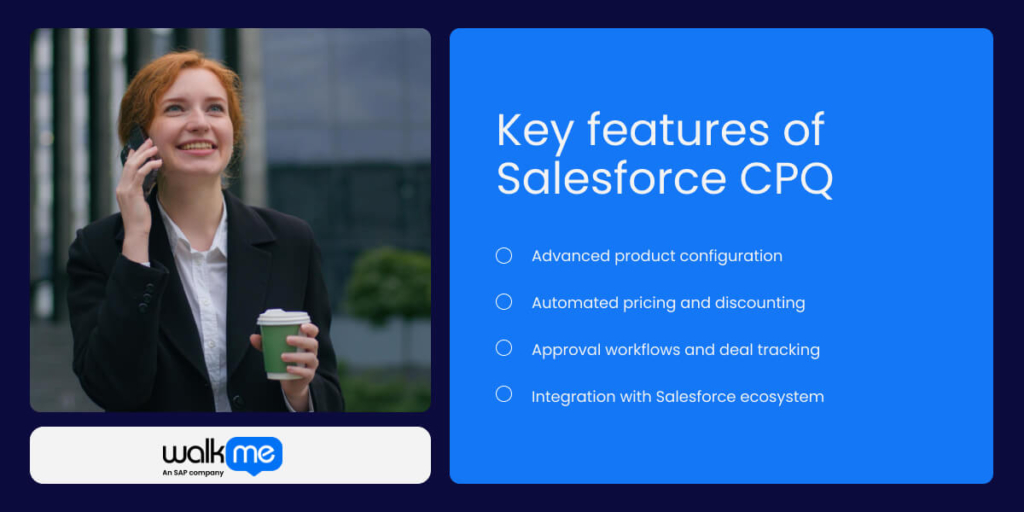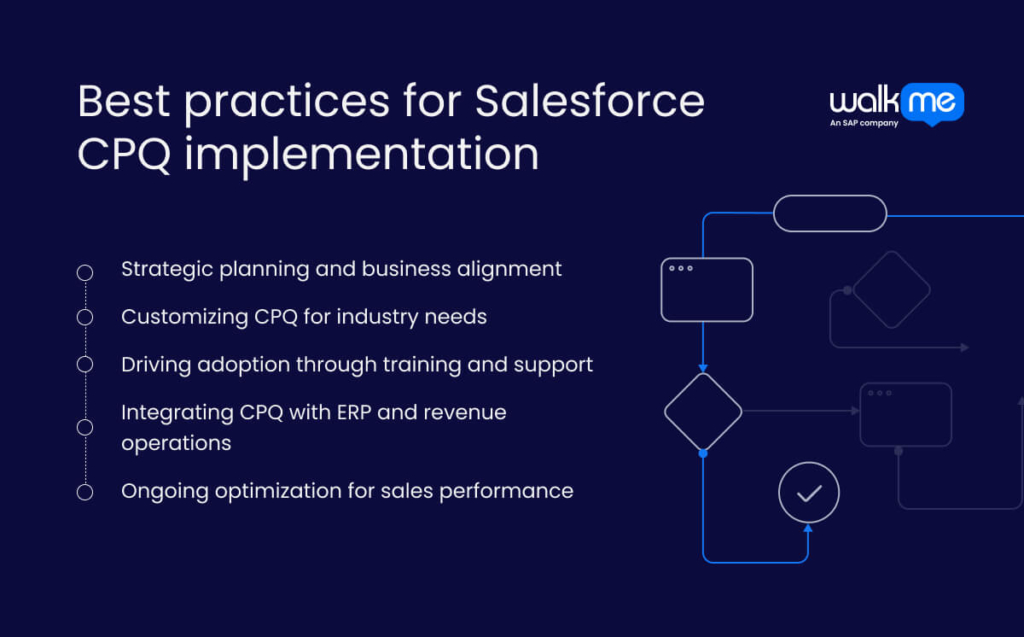Often, sales reps handle too many admin tasks and so lose time they could spend selling. They spend most of their day creating quotes, writing proposals, and getting approvals. This is instead of focusing on customer care and closing deals.
The process gets harder when reps have to create personalized quotes for complex products manually. As a result, they can make mistakes that damage the company’s image.
Salesforce CPQ solves this issue as it automates the configure, price, and quote process. It helps create a cross-functional team that closes deals faster. This article explains what Salesforce CPQ does, how it works, and how to use it well.
What is Salesforce CPQ (Configure, Price, Quote)?
Salesforce CPQ is a tool that helps sales teams streamline the sales process. It does this by allowing them to configure products, apply pricing, and generate quotes directly within the Salesforce platform.
Sales reps create accurate quotes faster because they manage all details in one place. They use customer history, preferences, and lead status from the Salesforce CRM to build quotes that match specific needs. This improves customer satisfaction and shortens the sales cycle.
In addition, the built-in AI and analytics tools support reps with personalized product and pricing suggestions. This CPQ also reviews customer data and buying patterns to recommend upsells, cross-sells, and discounts.
When someone updates product details, CPQ reflects those changes instantly. They can also send quotes directly to customers and get electronic signatures. All in all, teams spend less time on manual tasks and more time closing deals.
How Salesforce CPQ works
Salesforce CPQ helps sales teams give customers accurate and custom quotes. This lowers the chance of mistakes and makes the process faster.
Before you use it, you should learn about its three main parts:
Configuring complex products and services
In Salesforce CPQ, the configuration means adjusting complex products or services to fit a customer’s needs. For instance, CPQ helps create product bundles, allowing sales reps to offer combinations of products and services.
It also manages product dependencies, ensuring that certain features are available only when specific conditions are met. More importantly, CPQ guides sales reps through the process to select the right products and options.
Automating pricing strategies
The next step in creating a quote with Salesforce CPQ is pricing. Prices and discounts depend on factors like batch size, promotions, and partner terms (new customers, long-time partners, distributors, etc.).
Sales teams can use CPQ’s discounting tools and flexible pricing rules to automate calculations for various cases like retail, wholesale, one-time, or subscription sales. This speeds up the Salesforce sales process. Sales reps can also send special discount offers for approval during the pricing stage.
Generating accurate, professional quotes
The last stage of the Salesforce CPQ process is the generation of a quote in PDF format. This includes product details, prices, discounts, contact info, terms, and product specs.
CPQ provides customizable templates to adjust the look, content, and format of quotes. Once the sales rep customizes the template, they can send it directly to the customer through Salesforce CPQ. Then, the customer can sign it electronically.
Key features of Salesforce CPQ

Understanding Salesforce CPQ features helps you get the most out of the tool. You can speed up your sales process.
You can create and manage quotes more easily. You also improve accuracy. This leads to higher employee productivity and more sales.
These are the features you need to know:
Advanced product configuration
Salesforce CPQ helps create custom product bundles that adjust based on customer needs. Sales reps can quickly design and change configurations, ensuring they provide accurate proposals without mistakes. CPQ apps predict pricing scenarios and simplify the quoting process. This makes the quoting more accurate and efficient, helping your company build trust with customers.
By using pre-set rules and logic, the system ensures accuracy, even with complex products or services. In addition, the sales team can offer tailored solutions while this Salesforce automation software reduces errors. This feature improves overall efficiency, strengthens relationships with customers, and enhances the chances of closing deals.
Automated pricing and discounting
Salesforce CPQ features a dynamic pricing engine that helps businesses set flexible prices based on customer type, volume discounts, and contract terms. Sales teams can automate pricing and create competitive quotes to boost profitability. The system also offers real-time pricing guidance, giving sales reps the tools to negotiate effectively.
With configurable pricing rules, sales teams ensure consistent, accurate quotes while remaining competitive. Salesforce CPQ helps streamline the pricing process, reduces errors, and empowers sales representatives to make informed decisions, improving the chances of closing more deals and driving greater business success. This flexibility enhances overall sales performance.
Approval workflows and deal tracking
Custom workflows in Salesforce CPQ help teams speed up approvals and follow company rules. Managers get automatic alerts when they need to review and approve deals, which helps move deals along faster. These workflows improve visibility and cut down delays.
Sales teams can also use Salesforce CPQ’s powerful reporting tools to track deal performance. They monitor key metrics like quote turnaround time, win rates, and revenue by product. With this data, teams can spot trends, fix issues, and adjust strategies.
Integration with Salesforce ecosystem
Salesforce CPQ works closely with Salesforce CRM to give sales teams a single platform for managing customers and sales. Sales reps can view customer data, account details, and sales opportunities directly in the CPQ interface.
This setup also removes manual data entry and keeps information consistent across both systems. Salesforce CPQ also uses AI tools from Salesforce to give smart recommendations and predictions. These tools help sales teams make better choices, speed up the sales process, and close more deals.
Use cases for Salesforce CPQ
Knowing how to use Salesforce CPQ is key. It speeds up quotes and shortens deal cycles. This can lead to higher sales. You gain more control over pricing, product setup, and the steps in your sales process.
CPQ also gives you accurate data, which helps you plan and forecast better. You can also launch and manage complex pricing models like subscriptions or tiered pricing with ease.
Here are some of the ways you can use Salesforce CPQ within your organization:
Managing complex configurations in high-tech and manufacturing
Selling complex products in high-tech and manufacturing can challenge even skilled salespeople. CPQ software helps by automating the sales process, improving accuracy in quotes, and reducing errors. Sales teams use it to configure products quickly, suggest upsells, and manage customer data in one place.
CPQ also supports faster negotiations with clear pricing and delivery info. By storing all product information in one place, CPQ makes it easier to find and share details during sales talks.
Supporting global sales with multi-currency pricing
With Salesforce CPQ, you choose the currencies your company uses. Users can set their currency based on their business location. A Salesforce administrator can define the corporate currency and set it in the company settings. Salesforce then shows all values in that currency.
You can also manage the list of active currencies and their exchange rates. By setting up multiple currencies and user preferences, you help your team focus on their work instead of worrying about currency values.
Streamlining enterprise contract negotiations
In addition to generating quotes, Salesforce CPQ also lets your sales team generate contracts automatically using quote data and contract templates. They can use Contract
Amendments to update existing contracts by adding products, changing quantities, or ending subscriptions by setting the quantity to zero. These tools help your team keep contract records accurate and current.
Enhancing revenue forecasting with AI-driven analytics
Einstein Analytics enhances CPQ by turning data into valuable insights. It analyzes past sales, pricing trends, and customer behavior to help businesses forecast deal success. Next, it also enables businesses to adjust pricing strategies based on customer groups and market conditions.
With its predictive capabilities, businesses can manage inventory by anticipating product demand and identifying upsell and cross-sell opportunities based on a customer’s purchase history.
Best practices for Salesforce CPQ implementation

Best practices can help get the most from Salesforce CPQ. They assist you in speeding up sales, creating accurate quotes, and giving customers a better experience.
Focus on the practices below:
Strategic planning and business alignment
Before using this CPQ, create a clear Salesforce implementation plan. Define your business needs and goals for the system. Align these goals with your overall objectives to achieve the desired results. Involve key stakeholders early to gain support and address challenges right away.
Customizing CPQ for industry needs
Tailor Salesforce CPQ by adjusting product setups, pricing rules, and workflows to fit your business. Connect it with other systems and train your sales team on the new processes. This customization helps the system align with your needs and ensures your team uses it effectively to get the most value.
Driving adoption through training and support
Train your sales team and users to adopt Salesforce CPQ successfully. Offer sessions, workshops, and hands-on tutorials to teach the system’s features. Provide materials and resources for ongoing learning. Secure executive support and encourage continuous improvement to boost user adoption and maximize the system’s ROI.
Integrating CPQ with ERP and revenue operations
To integrate Salesforce CPQ with ERP and revenue operations, begin by defining the goals, data elements, outcomes, and timeline for the integration. Assess current systems for data quality and integration challenges.
Choose the best integration method, like middleware or API. Create data mapping rules and set up transformation and validation processes. Test the integration, prepare a change management plan, and monitor performance regularly.
Ongoing optimization for sales performance
Track key performance metrics and user feedback to measure Salesforce CPQ’s effectiveness and find areas for improvement. Use analytics tools to monitor digital adoption, usage, and business results.
In addition, ask users for feedback and use their input to improve the system. Update Salesforce CPQ based on performance insights to meet changing business needs.
Create an automated sales cycle with Salesforce CPQ
Salesforce CPQ helps your team move faster by automating tasks and reducing mistakes. It lets reps create accurate quotes, configure products, and manage contracts. Assign clear roles to admins, users, and support teams.
Set a process to review system changes and new features. Check workflows often and update them as needed. Track usage and performance with CPQ’s analytics tools. Gather feedback from users regularly. Use that input to improve the system. Keep refining CPQ so it stays aligned with your business goals.
FAQs
Salesforce CRM helps businesses manage their customer relationships and interactions. Salesforce CPQ makes the sales process easier by automating how products and services are set up, priced, and quoted.
Salesforce CPQ is useful for businesses with complex pricing or those wanting to speed up their quoting and sales. It helps by giving faster quotes, fewer errors, and a better customer experience.

